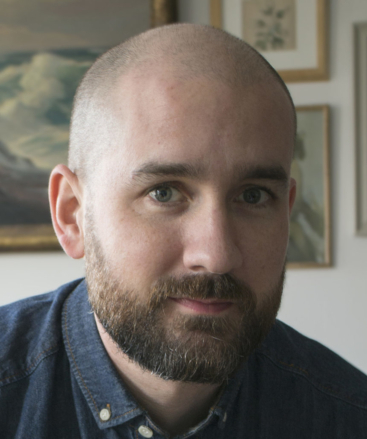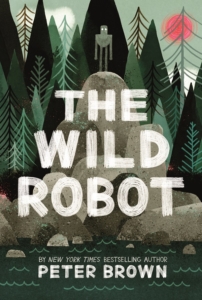
An Interview with Peter Brown
Peter Brown is best known both in this country and the US for his picture books, including the sublime Mr Tiger Goes Wild and My Teacher is a Monster. Now he’s written two novels for young children, The Wild Robot and The Wild Robot Escapes, just published in the UK by Piccadilly Press. The story of a robot who is shipwrecked on a desert island, and creates a life for herself there alongside the wild creatures, the stories are beautifully written and beautifully illustrated, sure to inspire all readers with affection for robot Roz, and also to set them thinking about what it means to be human. Books for Keeps caught up with Peter while on a recent trip to the UK.
 It was while he was working on his picture book The Curious Garden about a boy who becomes a gardener despite living in a grey, dreary city that the idea for The Wild Robot first came to Peter Brown. Pondering the most and least natural things he could imagine, he was struck with the image of a robot next to a tree. While it wasn’t right for the book he was working on, the image stayed with him: ‘Lots of my books tend to be “fish out of water stories” and this was the maybe most extreme example of that; plus it involved lots of my favourite things – I love science fiction, I love nature. The years passed and I made other picture books but I kept coming back to this robot-nature story idea and after a while decided I had to make this book.’
It was while he was working on his picture book The Curious Garden about a boy who becomes a gardener despite living in a grey, dreary city that the idea for The Wild Robot first came to Peter Brown. Pondering the most and least natural things he could imagine, he was struck with the image of a robot next to a tree. While it wasn’t right for the book he was working on, the image stayed with him: ‘Lots of my books tend to be “fish out of water stories” and this was the maybe most extreme example of that; plus it involved lots of my favourite things – I love science fiction, I love nature. The years passed and I made other picture books but I kept coming back to this robot-nature story idea and after a while decided I had to make this book.’
In his story Roz is shipwrecked on an island full of animals. Attempting to explore her new home, she quickly realizes that she will have to learn survival skills from the island’s wild inhabitants. Inadvertently destroying a nest of goose eggs, Roz ends up the adoptive mother to gosling Brightbill, and is suddenly responsible for another life too. Though Roz doesn’t feel emotions, she has been designed to do the best job possible, and bringing up her adopted son calls for all sorts of skills.
Having decided to tell the story, Peter began to research, finding out about robotics, artificial intelligence and animal behaviour – fascinating stuff. ‘The ideas were really interesting plus I was finding weird connections between what seemed like very different, almost opposite ideas. Pretty quickly I realised there was a lot of meat to this story. I wanted to let it breathe and see where the story took me.’ Peter’s story does prompt all sorts of ideas – about emotional intelligence, about the sorts of skills needed to live properly in society, skills that can only be learned from other living creatures. To do the story justice, Peter realised he would have to write it as a novel: ‘That was little scary’, he says, ‘I dragged my feet as didn’t want to give up a fairly successful picture book career to write a terrible children’s novel! I figured the only reason worth interrupting the momentum that I’d created in my picture book career was to do something interesting and worthwhile.’ He was happy to take his time, both in the research and the structure of his story, to get it right: ‘The thing about writing for kids of course, is that everything has to be distilled down to a form that will be fairly easily digested by a young person – that really forced me to understand the subject matter. I had to know the complicated version and find ways of simplifying it.’
His background research took him to robotic laboratories, but just as important was his readingup on fictional robots too: ‘I’ve read The Complete Robot collection of Isaac Asimov short stories probably 20 times now. It’s the book that really popularised robot stories and was helpful because each story is about a very different robot. At the beginning when I was trying to better understand my own character, it was helpful to see all these different robots.’ Roz at first seems like a stereotypical robot, but ‘I wanted readers to think they knew what the story is doing, then prove them wrong.’ RUR by Karel Čapek was another important influence, a story about robots rising up and taking over the planet. ‘Reading that was very helpful because I realised I didn’t want to tell that kind of story. It’s easy to go down that dystopian path but I thought there’s room for a robot character who’s more a saviour than a threat. I liked the idea of getting readers to care about a robot.’ Readers do care about Roz particularly when she adopts an orphaned gosling, bringing it up as her child with the help of other island creatures.
The decision to make Roz a female probably also helped there. In the first draft, Roz was it, but Peter found it was hard to care about his character when she was it, plus there’s that scene where Roz adopts Brightbill: ‘It seemed reasonable to me that a new born or infant’s first words are likely to be mother or mama – more so than papa. So I thought if this goose hatches from this egg shell and first thing he sees is Roz looking back he would call her mama. It just seemed then that by making Roz a she that whole scene would make sense. Once I’d made her a female, that whole scene just became much simpler.’ That wasn’t the only time he had to make revisions. ‘In an early draft Roz was a military robot and I went down that path for a while then realised if she was a military robot she’d probably be capable of violence, so if she was attacked by a bear she could just kill it. That’s not the point of the story and exploring that clarified for me that this story is about a peaceful robot. Every time I’d come to a dead end and I’d have to back up and realise what I wanted to do with the story – it took a lot of time but I gradually worked out that simpler is better and in fact the story ended up feeling almost like a fable in its simplicity – there’s no dates, no times, we don’t know exactly where the island is but it felt right to do it that way.’
Peter’s black and white illustrations add to the sense of the story being a fable. Initially he didn’t want to illustrate the book, but his publisher insisted. ‘I’m glad they did,’ he says now. ‘I feel the artwork really helps set the mood. In picture books you usually want the words and the pictures to be doing different things, in the Wild Robot books the art is really just reflecting what’s in the text, yet it adds to the moodiness of the story. Working in black and white was fun too, it’s simpler than working with colour and it allowed me to focus on the compositions and the drawings.’ Considering this he adds, ‘Between the art and the writing style and the subject matter, I was hoping to make a book that would have been readable twenty years ago and will hopefully be readable twenty years from now.’ In The Wild Robot and its sequel The Wild Robot Escapes Peter has indeed succeeded in his aim, the books deserve to be read for years to come, their message of love, welcome and the importance of community, is unlikely to date, whatever form our future takes.
Andrea Reece is managing editor of Books for Keeps.
The Wild Robot and its sequel The Wild Robot Escapes are published by Piccadilly Press, £6.99 each.





